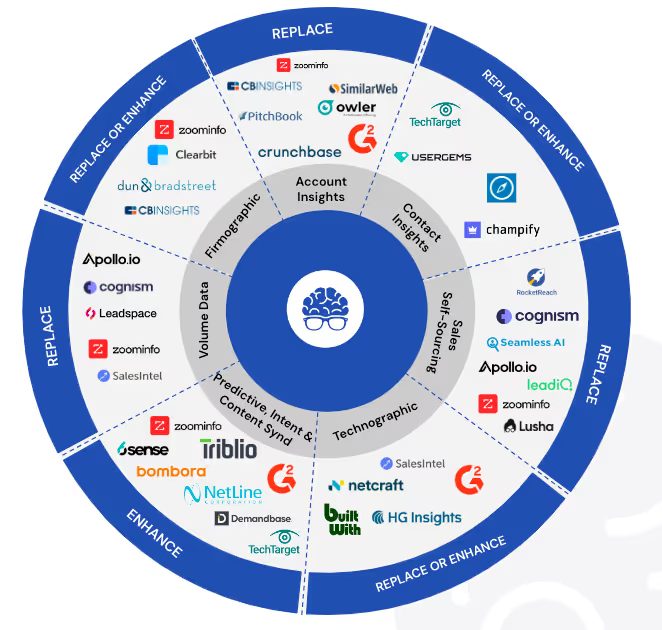Over the past year, the go-to-market (GTM) technology landscape has been consolidating at breakneck speed. Salesloft, Drift, and Clari—three of the most important players in sales engagement, conversational marketing, and revenue intelligence—have positioned themselves as the backbone of modern revenue operations. The promise was simple: unify signals, conversations, and forecasting into one seamless motion.
But the recent string of breaches tied to Drift and Salesloft exposes a darker reality: consolidation can concentrate not only power, but also risk. And when that risk is exploited, the fallout is potentially catastrophic.
The Breach: 1.5 Billion Records, 760 Companies, One Weak Link
According to disclosures and reporting, the ShinyHunters extortion group—along with affiliated threat actors now styling themselves as “Scattered Lapsus$ Hunters”—used compromised OAuth tokens from Salesloft Drift integrations to infiltrate Salesforce environments at scale.
The result? Roughly 1.5 billion records stolen from 760 companies, including sensitive Salesforce “Account,” “Contact,” “Case,” “Opportunity,” and “User” tables. Case tables in particular contained customer support interactions, some of which included sensitive or credential-like information.
High-profile victims include Google, Cloudflare, Zscaler, Palo Alto Networks, Tenable, Proofpoint, Elastic, and even TransUnion, which confirmed the exposure of 4.4 million U.S. consumers’ data. Farmers Insurance disclosed a parallel breach affecting over a million customers.
The attack chain traces back to a March 2025 Salesloft GitHub compromise, where ShinyHunters used tools like TruffleHog to extract secrets—including Drift and Drift Email OAuth tokens—from the source code. Those tokens then became skeleton keys into connected Salesforce orgs.
Why Consolidation Made Things Worse
Individually, Drift, Salesloft, and Clari each represented specialized functionality. Combined, they create a tightly coupled system designed to be the nervous system of enterprise GTM teams. That’s their value proposition—but also their Achilles’ heel.
- Single Point of Failure: By linking conversational data (Drift), engagement cadences (Salesloft), and forecasting pipelines (Clari) into Salesforce, the integration surface exploded. Compromise one link in the chain, and you inherit the keys to the kingdom.
- OAuth Blind Spots: OAuth tokens are a blessing for user convenience but a curse for security when stored or managed improperly. Few security teams monitor third-party OAuth apps with the same rigor as internal credentials.
- Data Centralization = Ransom Leverage: GTM platforms house not only PII but also commercial intelligence—deal sizes, opportunities, customer pain points—that is invaluable to both competitors and extortion groups. The consolidation amplified the “blast radius” of a single breach.
Echoes of ZoomInfo, Apollo, and Beyond
The incident also highlights a structural weakness in the B2B data and engagement space. Platforms that aggregate and centralize vast swaths of customer intelligence become prime extortion targets. We saw this last year when Apollo and Seamless faced takedowns of LinkedIn scraping functionality, and when ZoomInfo’s practices drew regulatory and legal scrutiny.
But the Salesloft–Drift–Clari cluster is arguably more dangerous. Why? Because it’s not just data in motion—it’s the actual operating system for sales teams. If those systems can’t be trusted, the go-to-market machine breaks down.
The Fallout: What This Means for GTM Leaders
For CROs, CMOs, and RevOps executives, the implications are massive:
- Operational Risk: Outbound and inbound pipelines depend on Salesforce trust. If that trust is undermined, productivity grinds to a halt.
- Compliance and Liability: Exposure of PII and deal data will lead to lawsuits, regulatory probes, and significant remediation costs. TransUnion is already bracing for class actions.
- Vendor Scrutiny: Expect procurement teams to double down on third-party risk assessments, demanding proof of OAuth governance, secret management, and incident response maturity.
- Market Shakeup: If consolidation promised efficiency, this breach may trigger a swing back toward modular, API-first tools where risk is segmented, not concentrated.
The Broader Question: Can We Trust the GTM Stack?
This breach should serve as a wake-up call. GTM leaders need to ask: Are we building castles on sand? The tools that promised hyper-efficiency may be creating existential vulnerabilities.
Salesforce itself has pushed for stricter security controls—multi-factor authentication, least-privilege access, and connected-app oversight—but the Drift/Salesloft hack proves that the ecosystem is only as strong as its weakest integration.
In short: if the GTM platforms consolidating into category killers can’t harden their security posture, the very business model of “revenue operating systems” may collapse under the weight of breaches and extortion.
Conclusion
The Drift–Salesloft hack isn’t just another breach. It’s a systemic failure that reveals the risks of consolidating sensitive customer and revenue data into a handful of highly integrated platforms.
The attackers understand the stakes: steal the lifeblood of GTM operations, and you can ransom the future of a company. The only question left is whether GTM leaders will rethink their reliance on monolithic platforms—or whether we’ll continue to consolidate until the next breach takes down not just data, but entire businesses.




